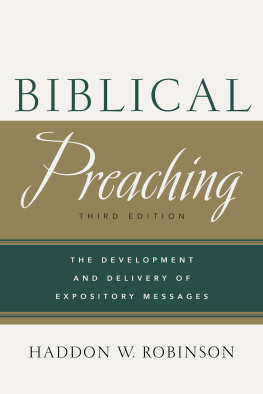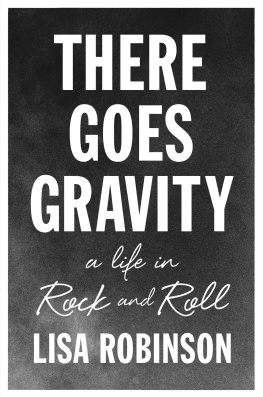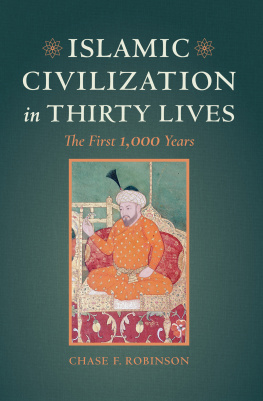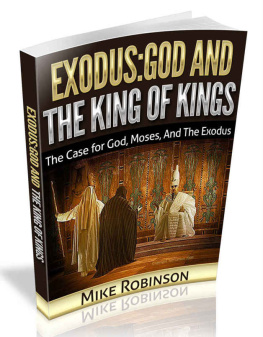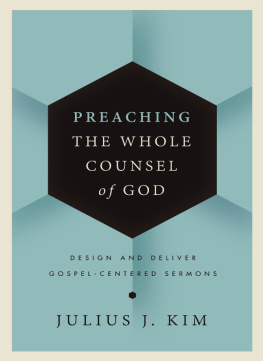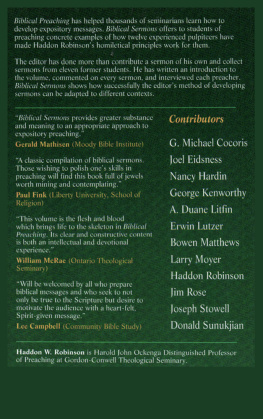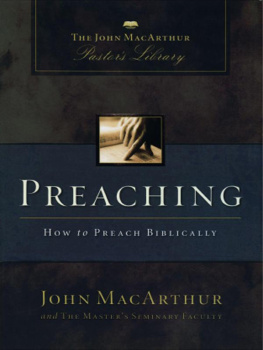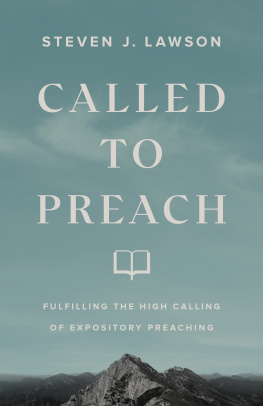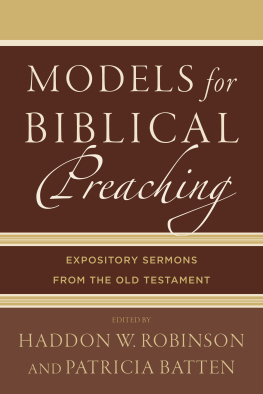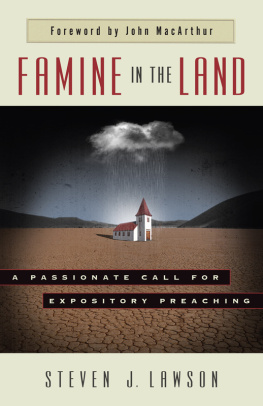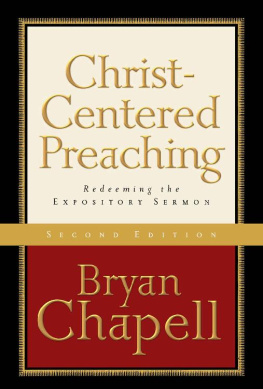
1980, 2001, 2014 by Haddon W. Robinson
Published by Baker Academic
a division of Baker Publishing Group
P.O. Box 6287, Grand Rapids, MI 49516-6287
www . bakeracademic . com
Ebook edition created 2014
All rights reserved. No part of this publication may be reproduced, stored in a retrieval system, or transmitted in any form or by any meansfor example, electronic, photocopy, recordingwithout the prior written permission of the publisher. The only exception is brief quotations in printed reviews.
Library of Congress Cataloging-in-Publication Data is on file at the Library of Congress, Washington, DC.
ISBN 978-1-4412-4534-2
Scripture quotations labeled ASV are from the American Standard Version of the Bible.
Scripture quotations labeled KJV are from the King James Version of the Bible.
Scripture quotations labeled NASB are from the New American Standard Bible, copyright 1960, 1962, 1963, 1968, 1971, 1972, 1973, 1975, 1977, 1995 by The Lockman Foundation. Used by permission.
Scripture quotations labeled NIV are from the Holy Bible, New International Version. NIV. Copyright 1973, 1978, 1984, 2011 by Biblica, Inc. Used by permission of Zondervan. All rights reserved worldwide. www.zondervan.com
Scripture quotations labeled NKJV are from the New King James Version. Copyright 1982 by Thomas Nelson, Inc. Used by permission. All rights reserved.
Scripture quotations labeled NRSV are from the New Revised Standard Version of the Bible, copyright 1989, by the Division of Christian Education of the National Council of the Churches of Christ in the United States of America. Used by permission. All rights reserved.
Scripture quotations labeled Phillips are from The New Testament in Modern English, revised editionJ. B. Phillips, translator. J. B. Phillips 1958, 1960, 1972. Used by permission of Macmillan Publishing Co., Inc.
Scripture quotations labeled RSV are from the Revised Standard Version of the Bible, copyright 1952 [2nd edition, 1971] by the Division of Christian Education of the National Council of the Churches of Christ in the United States of America. Used by permission All rights reserved.
Scripture quotations not labeled with a translation are the authors own translations.
To the men and women
who keep a sacred appointment
on Sunday morning.
Bewildered by seductive voices,
nursing wounds life has inflicted upon them,
anxious about matters that do not matter.
Yet they come to listen for a clear word from God
that speaks to their condition.
And to those who minister to them now
and those who will do so in the future.
Contents
Cover
Title Page
Copyright Page
Preface
Dedication
1. The Case for Expository Preaching
2. Whats the Big Idea?
3. Tools of the Trade
4. The Road from Text to Sermon
5. The Arrow and the Target
6. The Shapes Sermons Take
7. Making Dry Bones Live
8. Start with a Bang and Quit All Over
9. The Dress of Thought
10. How to Preach So People Will Listen
A Final Word
Sample Sermon and Evaluation
Student Exercises
Answers to Student Exercises
Bibliography
Scripture Index
Subject Index
Back Cover
Preface
L ewis Chafer began the preface to his massive eight-volume set on theology with the simple words, To be read. In this preface I would like to give credit to people and forces that have shaped my approach to biblical preaching, and I would appreciate if you would read it.
I have been fascinated with preaching since I was in my early teens. As a boy I began a series of diaries that recorded the tedious events of a fairly humdrum life. Years later when cleaning out my fathers apartment, I came across one of those diaries. Apparently on a Thursday evening I had gone to a service at the First Baptist Church in New York City to hear Dr. Harry Ironside preach. Ironside was the pastor of the Moody Church in Chicago. I cant imagine what attracted me to a religious gathering on a Thursday evening. At the time I was sure that God kept office hours on Sunday morning. Yet I wrote in my diary, Some preachers preach for an hour and it seems like thirty minutes; others preach for thirty minutes and it seems like an hour. I wonder what the difference is?
I have spent my life trying to answer that question.
In college I spent many Friday evenings at the library reading books on preaching. I read several of the Yale lectures. I was swimming in deep waters, and though I didnt fully understand what I was reading, I read anyhow. When I arrived at Dallas Seminary after graduation, I was disappointed to find there wasnt much instruction offered on preaching. Dallas wasnt alone in slighting the practical disciplines. Most seminaries at the time did not have courses in Christian education, counseling, pedagogy, or preaching. It was assumed, I guess, that if you knew the content you could communicate it. During my senior year a few of my classmates asked me to teach a course in preaching on Tuesday evenings, and I agreed. I taught them all that I knew (and much I didnt know, for that matter), and in the process I learned more about the subject of homiletics than any of the other students in the group.
After graduation I served at the First Baptist Church in Medford, Oregon, and while I was there the administration at Dallas invited me to come back and help in the expanded preaching department. When I went back to my alma mater, I tried to figure out what I didnt know about the field of communication (an enormous amount) and preaching (not a subject that academics care much about). So while I taught at the seminary I earned a masters degree from Southern Methodist University and after that a PhD at the University of Illinois. I minored in sociology at SMU, and in radio/TV at Illinois. It turned out that I have used my minors more than my majors. All this education was an attempt to answer the question, What makes a preacher interesting and a sermon effective?
While at the University of Illinois I began to work through the basic elements in the preparation of sermons. The subject was not addressed directly at the university, but my first basic insight came during a class on oral interpretation. We were studying a poem by e. e. cummings that I had been assigned to deliver to the class the following week. During my preparation I realized that we were asking the same kinds of questions to interpret the poem that we used at seminary to interpret a passage in the Bible.
During my first semester after I returned to Dallas I read Design for Preaching by H. Grady Davis. That book changed my concept of what a sermon should be. In later years when I was writing the first edition of Biblical Preaching , I went back to Daviss book to give him proper credit for his ideas, and I wondered whether he would have been complimented or insulted by my references to him. I owe him a great debt, though, for the way his book influenced me.
This is the third edition of Biblical Preaching . Why a third edition? Over the years I have received a great deal of feedback from teachers and readers of the book. Most of the response has been positive, and I thank God for the way he has used Biblical Preaching in the education of those who proclaim his Word. The negative responses centered on the exercises provided to reinforce the teaching in the book. For many readers they simply didnt work. Robert Permenter, a graduate of the DMin program at Gordon-Conwell and a teacher of preaching at Bethel Seminary, came to my aid. Bob contributed a number of new exercises for this edition, and the two of us have tested them with students in several classes at two different seminaries. I hope you will find them helpful in understanding the counsel offered throughout this book.

